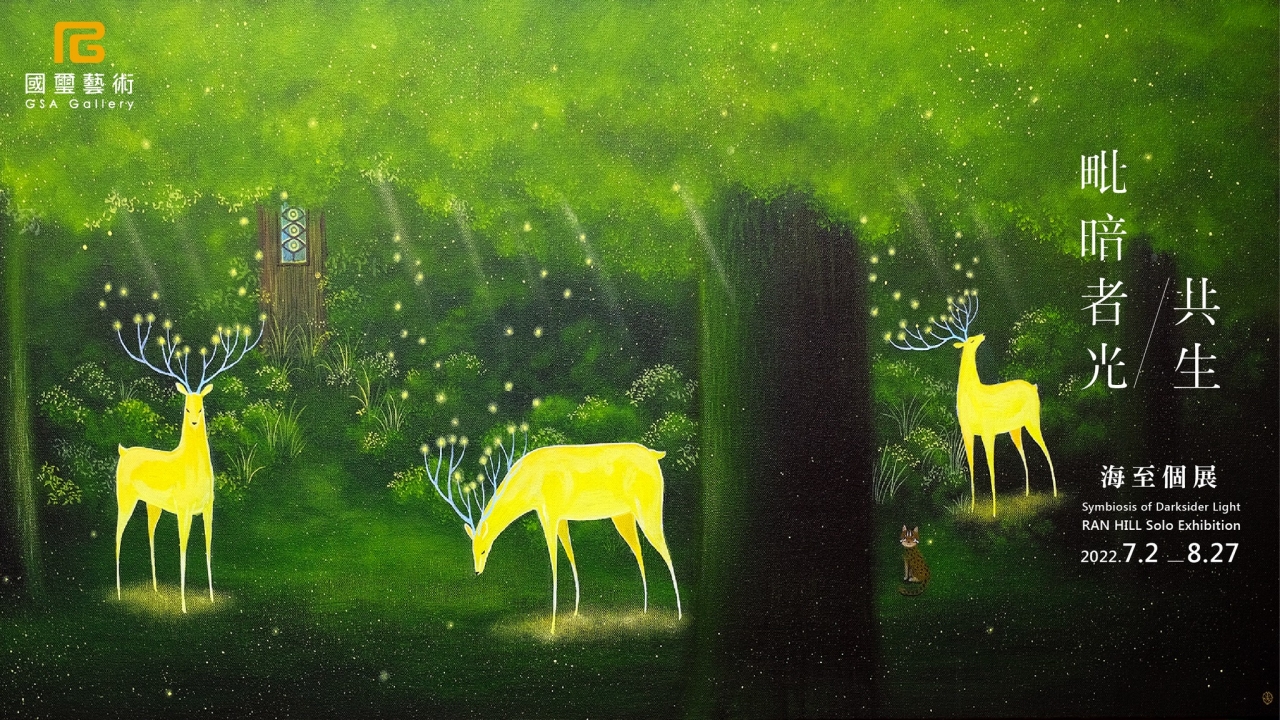
2022 Symbiosis of Darksider Light - Ran Hill Solo Exhibition 「毗暗者光-共生」海至個展
Jul 2 - Aug 27, 2022
2022 Symbiosis of Darksider Light
Author/Selena 2022/06/03
In recent years, the plight of the Formosan clouded leopard cat (石虎) in Taiwan has drawn widespread public attention. Whether through efforts to preserve natural ecosystems or artificial breeding programs, these elusive wildcats have finally found a sliver of breathing space—a chance to survive against the odds. From a human perspective, we seem to be protectors of the ecosystem and of the leopard cats themselves. But from the leopard cat’s point of view, they are beings forced to confront the relentless encroachment of their habitat, pushed to the brink of extinction. They have no choice but to passively accept and adapt—coexisting with adversity, not by strategy, but out of necessity.
In 2020, artist Hai Chih began to use his art to speak on behalf of the Formosan leopard cat. His feline subjects often appear healing and adorable, but in their backward glances, one can sense a quiet unease, a subtle melancholy. Among Hai Chih’s many works on this theme, one particularly memorable piece depicts a leopard cat guiding a lost Formosan black bear cub. The inspiration came from a true story in July 2018: near Nanan Waterfall in Hualien, a bear cub, no larger than a kitten, was found alone—separated from its mother. Media reports spurred an influx of tourists eager to snap photos. The cub, nicknamed “Mei-Zai” (Little Sister), was eventually cared for by a wildlife rescue team and spent nearly nine months on the long journey back to the wild. Like the leopard cat, the bear was another passive participant—forced to coexist in a destroyed environment, not by design, but by circumstance.
Then in 2019, the COVID-19 pandemic spread across the globe. Humanity suddenly found itself facing illness and survival threats. By 2022, Taiwan’s pandemic strategy shifted from early eradication policies toward one of coexistence with the virus—a strategic adaptation. In contrast to wild animals, humans could choose how to coexist with adversity.
The artist’s sensitivity is the wellspring of creative inspiration. Hai Chih states that he records life through his art. On another level, he channels his emotional responses to life, the environment, and others through brush and canvas—translating feeling into form.
In 2013, Hai Chih created the character “Light Deer”, which became the foundation of a long-running series centered on the theme of light:
• 2015: Light appeared as the gentle rays of a rising sun—symbolizing hope.
• 2016: Even faint, slow-dawning light held infinite promise and power—steady and unending.
• 2017: In the nourishing embrace of light, all things are reborn—an expression of gratitude and reciprocal care.
• 2018: Continuing a promise made with a departed friend, he sought to pass on the warmth of life, realizing that the path to great compassion is to receive it—and to give it again.
• 2020: His creative process deepened into a philosophical exploration of life’s meaning. Beyond offering comfort, his works aimed to resonate with viewers—encouraging those who were healed to become beacons for others, embracing a ripple effect of shared light and empathy.
By 2022, amidst the global uncertainty, Hai Chih was particularly attuned to a collective sense of helplessness and fear. Revisiting his series on light, he recognized that these works represent an ongoing journey of seeking, discovering, and understanding light. This reflection led to a powerful realization:
“Where there is darkness, there is light.”
We often flee from darkness, striving toward light—but dawn rises from the night. Darkness and light are not opposites, but two inseparable aspects of existence—coexisting, intertwined. This insight solidified the conceptual foundation of his series, becoming the core theme and title of this exhibition.
毗暗者光 -共生 史訥訥Selena 2022/06/03
這幾年,在臺灣石虎的生存問題,引起大眾廣泛注意,無論是自然生態的注重保存或人為的複育,石虎似乎有了絶處逢生的喘息機會。就人類的角度而言,我們看似保護生態和石虎,而就石虎而言,牠們正在面臨原本生存環境逐漸被剝奪而必須瀕臨滅絶的危機,牠們只能無奈的接授和適應-石虎是在和逆境共存而共生。
2020年,海至開始有了用作品為石虎發聲的想法。他筆下的石虎,有療癒可愛的外表,卻在回眸一顧的眼神中,讓人看見一抹隱隱的不安和憂鬱!在海至一系列關於石虎的創作中,有一幅令人印象深刻的作品,畫面是 “一隻石虎幫幼小的台灣黑熊領路” ,作品的創作靈感來自於2018年7月,台灣花蓮南安瀑布附近,發現一隻體型如小貓一般的台灣黑熊,小黑熊和牠的媽媽走失,在媒體報導下,引來各方關注和大批遊客爭相拍照;最後這隻被暱稱為『妹仔』的小黑熊,在保育團隊協助下,展開長達近9個月的返鄉之路。而無論是石虎或黑熊,都是被動接受被破壞的生存環境、與之共存-不是策略也沒有選擇!
2019年,covid-19擴散全球:人類面臨疾病和生存的威脅!而台灣於2022年疫情升温,我們的防疫政策從一開始的清零,慢慢導向與世界同步-“與疾病共存”,人類有策略的接受和適應!也是在和逆境共存而共生。
藝術家的善感,正是作品靈感的泉源。海至說-他用創作記錄生活!另方面來說,藝術家用自己的感知把對生命、環境與人的情感付諸筆下、形而於作品!
海至於2013年創作了『光鹿』此一角色,並以此創作出一系列關於『光』的作品和展覽-
2015,表逹的是 -從日初將近、煦煦的微光中可以看見希望!
2016,表逹的是 -曙光即便微小緩慢,帶給人無限希望和力量,是持續不斷、綿延不絶的!
2017,表逹的是 -徜徉在光的滋養中,大地萬物得以重生,也延伸出反饋和感恩的含意。
2018則延續自己與已故好友約定,進而把生命感受的温暖傳遞下去!領悟回饋大愛的方法,是仿效大愛而授之予大愛。
2020是藝術家在創作歷程中,開始對不同的生命觀有更深層次的探索,希望聚合心靈的頻率;作品除了想讓人得到光的力量,更希望獲得撫慰的人,也可以再次去照亮別人!有以一傳十、推己及人的概念!
今年(2022),藝術家特別有感於自身和整個世界的人類,正在共同經歷困頓於逆境中的無助,以及人們對於無法預期的未來感到恐懼…在自己的創作日常中,再再回首、檢視這一系列關於光的作品,正是一連串尋找、發現、和探索光的過程!因此更從中恍然大悟:『毗暗者,光也!』;人們總是拒避黑暗、追求光,然而黎明即起於黑夜!黑暗與光,兩者其實是一體的兩面、共體共存的呀!因此更確立了此系列作品的創作脈絡;以此為名,成為這次展覽的主軸!
Author/Selena 2022/06/03
In recent years, the plight of the Formosan clouded leopard cat (石虎) in Taiwan has drawn widespread public attention. Whether through efforts to preserve natural ecosystems or artificial breeding programs, these elusive wildcats have finally found a sliver of breathing space—a chance to survive against the odds. From a human perspective, we seem to be protectors of the ecosystem and of the leopard cats themselves. But from the leopard cat’s point of view, they are beings forced to confront the relentless encroachment of their habitat, pushed to the brink of extinction. They have no choice but to passively accept and adapt—coexisting with adversity, not by strategy, but out of necessity.
In 2020, artist Hai Chih began to use his art to speak on behalf of the Formosan leopard cat. His feline subjects often appear healing and adorable, but in their backward glances, one can sense a quiet unease, a subtle melancholy. Among Hai Chih’s many works on this theme, one particularly memorable piece depicts a leopard cat guiding a lost Formosan black bear cub. The inspiration came from a true story in July 2018: near Nanan Waterfall in Hualien, a bear cub, no larger than a kitten, was found alone—separated from its mother. Media reports spurred an influx of tourists eager to snap photos. The cub, nicknamed “Mei-Zai” (Little Sister), was eventually cared for by a wildlife rescue team and spent nearly nine months on the long journey back to the wild. Like the leopard cat, the bear was another passive participant—forced to coexist in a destroyed environment, not by design, but by circumstance.
Then in 2019, the COVID-19 pandemic spread across the globe. Humanity suddenly found itself facing illness and survival threats. By 2022, Taiwan’s pandemic strategy shifted from early eradication policies toward one of coexistence with the virus—a strategic adaptation. In contrast to wild animals, humans could choose how to coexist with adversity.
The artist’s sensitivity is the wellspring of creative inspiration. Hai Chih states that he records life through his art. On another level, he channels his emotional responses to life, the environment, and others through brush and canvas—translating feeling into form.
In 2013, Hai Chih created the character “Light Deer”, which became the foundation of a long-running series centered on the theme of light:
• 2015: Light appeared as the gentle rays of a rising sun—symbolizing hope.
• 2016: Even faint, slow-dawning light held infinite promise and power—steady and unending.
• 2017: In the nourishing embrace of light, all things are reborn—an expression of gratitude and reciprocal care.
• 2018: Continuing a promise made with a departed friend, he sought to pass on the warmth of life, realizing that the path to great compassion is to receive it—and to give it again.
• 2020: His creative process deepened into a philosophical exploration of life’s meaning. Beyond offering comfort, his works aimed to resonate with viewers—encouraging those who were healed to become beacons for others, embracing a ripple effect of shared light and empathy.
By 2022, amidst the global uncertainty, Hai Chih was particularly attuned to a collective sense of helplessness and fear. Revisiting his series on light, he recognized that these works represent an ongoing journey of seeking, discovering, and understanding light. This reflection led to a powerful realization:
“Where there is darkness, there is light.”
We often flee from darkness, striving toward light—but dawn rises from the night. Darkness and light are not opposites, but two inseparable aspects of existence—coexisting, intertwined. This insight solidified the conceptual foundation of his series, becoming the core theme and title of this exhibition.
毗暗者光 -共生 史訥訥Selena 2022/06/03
這幾年,在臺灣石虎的生存問題,引起大眾廣泛注意,無論是自然生態的注重保存或人為的複育,石虎似乎有了絶處逢生的喘息機會。就人類的角度而言,我們看似保護生態和石虎,而就石虎而言,牠們正在面臨原本生存環境逐漸被剝奪而必須瀕臨滅絶的危機,牠們只能無奈的接授和適應-石虎是在和逆境共存而共生。
2020年,海至開始有了用作品為石虎發聲的想法。他筆下的石虎,有療癒可愛的外表,卻在回眸一顧的眼神中,讓人看見一抹隱隱的不安和憂鬱!在海至一系列關於石虎的創作中,有一幅令人印象深刻的作品,畫面是 “一隻石虎幫幼小的台灣黑熊領路” ,作品的創作靈感來自於2018年7月,台灣花蓮南安瀑布附近,發現一隻體型如小貓一般的台灣黑熊,小黑熊和牠的媽媽走失,在媒體報導下,引來各方關注和大批遊客爭相拍照;最後這隻被暱稱為『妹仔』的小黑熊,在保育團隊協助下,展開長達近9個月的返鄉之路。而無論是石虎或黑熊,都是被動接受被破壞的生存環境、與之共存-不是策略也沒有選擇!
2019年,covid-19擴散全球:人類面臨疾病和生存的威脅!而台灣於2022年疫情升温,我們的防疫政策從一開始的清零,慢慢導向與世界同步-“與疾病共存”,人類有策略的接受和適應!也是在和逆境共存而共生。
藝術家的善感,正是作品靈感的泉源。海至說-他用創作記錄生活!另方面來說,藝術家用自己的感知把對生命、環境與人的情感付諸筆下、形而於作品!
海至於2013年創作了『光鹿』此一角色,並以此創作出一系列關於『光』的作品和展覽-
2015,表逹的是 -從日初將近、煦煦的微光中可以看見希望!
2016,表逹的是 -曙光即便微小緩慢,帶給人無限希望和力量,是持續不斷、綿延不絶的!
2017,表逹的是 -徜徉在光的滋養中,大地萬物得以重生,也延伸出反饋和感恩的含意。
2018則延續自己與已故好友約定,進而把生命感受的温暖傳遞下去!領悟回饋大愛的方法,是仿效大愛而授之予大愛。
2020是藝術家在創作歷程中,開始對不同的生命觀有更深層次的探索,希望聚合心靈的頻率;作品除了想讓人得到光的力量,更希望獲得撫慰的人,也可以再次去照亮別人!有以一傳十、推己及人的概念!
今年(2022),藝術家特別有感於自身和整個世界的人類,正在共同經歷困頓於逆境中的無助,以及人們對於無法預期的未來感到恐懼…在自己的創作日常中,再再回首、檢視這一系列關於光的作品,正是一連串尋找、發現、和探索光的過程!因此更從中恍然大悟:『毗暗者,光也!』;人們總是拒避黑暗、追求光,然而黎明即起於黑夜!黑暗與光,兩者其實是一體的兩面、共體共存的呀!因此更確立了此系列作品的創作脈絡;以此為名,成為這次展覽的主軸!

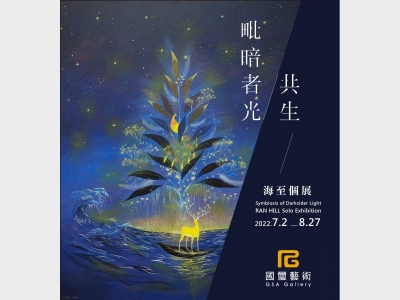
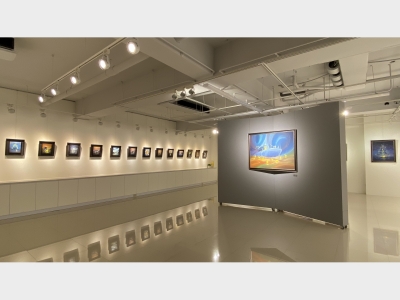
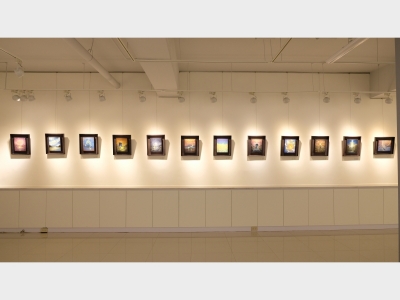
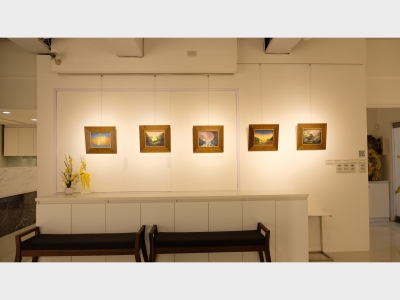
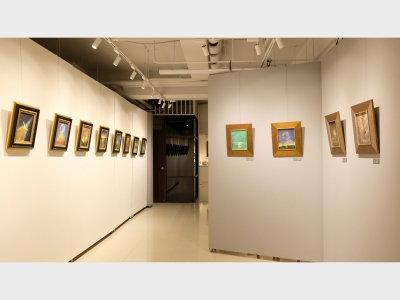
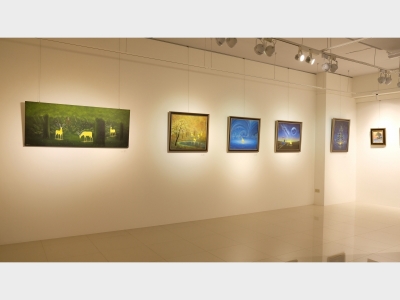
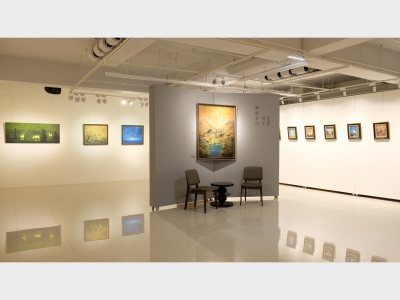

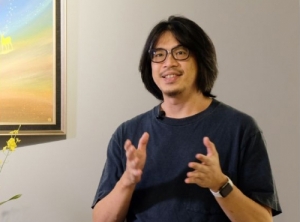 RAN HILL 海至
RAN HILL 海至